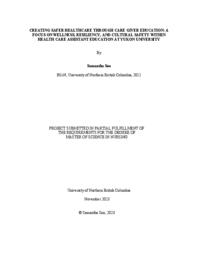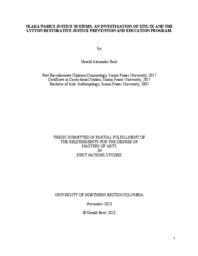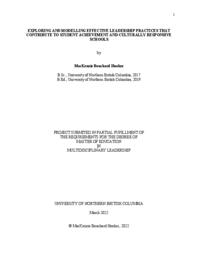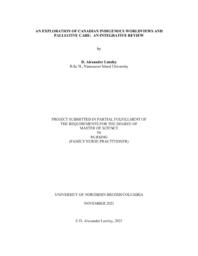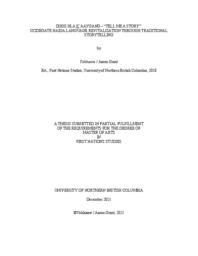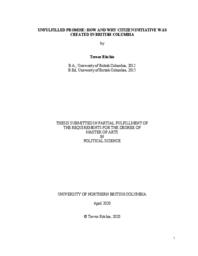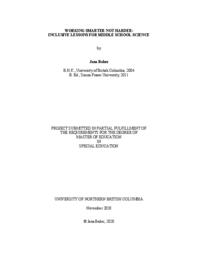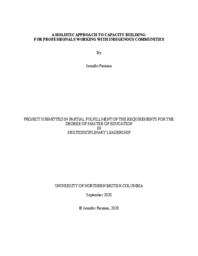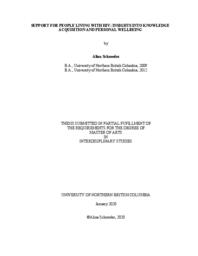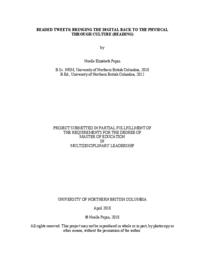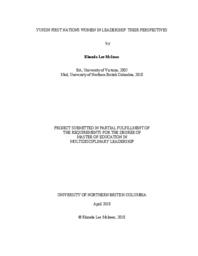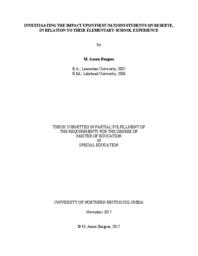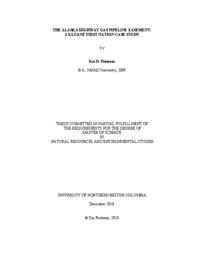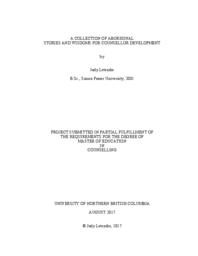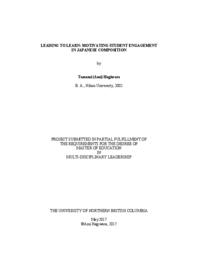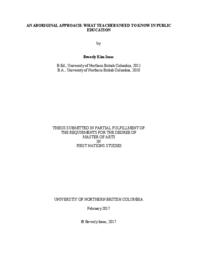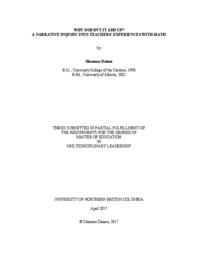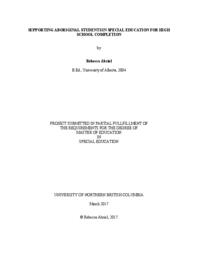Fraser, Tina
Person Preferred Name
Tina Fraser
Related Works
Content type
Digital Document
Description / Synopsis
This project aimed to enhance the foundational knowledge and skills related to wellness, resiliency, and cultural safety education for students in the Health Care Assistant (HCA) program at Yukon University. By revising the HCA 111 course, the project aimed to prepare students for success as front-line caregivers. Project objectives included conducting a literature review, engaging with Scandinavian colleges and universities, conversations with employed Yukon HCAs, consulting with local Indigenous knowledge holders on course revisions, and revising and delivering the course. This project addresses pressing needs in the Yukon healthcare system such as caregiver burnout and Indigenous-specific racism and discrimination. The revisions incorporated self-awareness learning, Elder-led learning, land-based learning, community experiential learning, and cultural safety education. The socio-ecological model and the First Nations perspective on health and wellness model guided the course revisions through a Two- Eyed Seeing approach in conjunction with cultural principles of meaningful relationships (9 Rs) and flexible content delivery to promote student wellness, resilience, and cultural safety. This project contributes to creating safer health care environments for both caregivers and Yukon Indigenous health care recipients.
Origin Information
Content type
Digital Document
Description / Synopsis
This thesis investigates an Indigenous community’s traditional justice model called Xitl’ix, as well as the Lytton Restorative Justice Prevention and Education Program that is currently being utilized by members of the Lytton Indian Band. This qualitative study uses Indigenous Storywork Methodology and Narrative Inquiry, to explore the participants’ experiences with Xitl’ix and the Lytton Restorative Justice program. Due to the global pandemic, several video conference interviews, which the researcher refers to as virtual sharing circles, were held with eight participants. Six participants are from the Lytton Indian Band, one participant is a non-Status Indian and former director of the Lytton Restorative Justice Prevention and Education Program, and the last participant is a settler person who is a former high school principal. Each participant provided their perspective about Xitl’ix (Nlaka’pamux Court), the Lytton Restorative Justice Prevention and Education Program and/or Restorative Justice programs and services. The themes that emerged from the virtual sharing circles include Nlaka’pamux Knowledge, Indigenous healing, and ultimately provided a stronger foundation of understanding of the Xitl’ix teachings and the Lytton Restorative Justice Prevention and Education Program. During one of the virtual sharing circles and unexpected finding was revealed that described another Nlaka’pamux justice system, which has not been memorialized or described in past research about the Nlaka’pamux people.
Origin Information
Content type
Digital Document
Description / Synopsis
The purpose of this research project is to create an educational tool in the form of a children’s book. My aim is to spark discussions regarding equity, inclusion, and identity for children ages four to six-year-old. This research project proposal is divided into six chapters. Chapter One introduces the framework for the proposed case study. Chapter Two provides a literature review, exploring the relationships between bibliotherapy, animals and people. Chapter Three provides a description of the qualitative methodology and description of the method process. Chapter Four outlines the findings and evaluation of the case study. Chapter Five describes the proposed children’s book manuscript and future aspirations for Through the Eyes of a Dog. Chapter Six presents the lessons learned and recommendations based on the research journey.
Origin Information
Content type
Digital Document
Description / Synopsis
School leadership has a profound impact in the quality of education that students receive. Low student achievement, and especially the Indigenous student achievement gaps, are very much needing to be addressed and could be mitigated through shifts in leadership practices. No recent studies have explored the niche educational landscape and challenges that are in Northern British Columbia. With high teacher turnover and low Indigenous student achievement, further research was drastically needed to identify what leadership practices should be used in schools, and what types of leaders are needed to properly exemplify these practices. This study involved the qualitative analysis of scholarly articles pertaining to educational leadership and promoting student achievement and positive change. The research identified four key areas that paint a better picture of what schools and their leaders should look like in a culturally responsive world: the descriptors of an effective school setting, the roles of an effective school principal, the characteristics of an effective leader, and the undesired characteristics of schools and their leaders. The research identified that effective school settings possess environments where there are specific educational and professional standards, where students are the focus and community building is a priority, and where the atmosphere reflects cultural safety. Effective school leaders were found to provide a quality education, lead positive change, complete administrative and management tasks, take on proactive and intentional planning, and establish community-wide connections with their school. In regard to the types of leaders that should be at the helm of our schools, effective leaders exhibit a leadership persona, possess individual personality traits that make them suitable to lead, and have a strong professional reputation. Lastly, it was important to identify the undesired characteristics of schools and their leaders so that professionals were aware of not only the good practices, but the components that they must avoid. The schools that are not conducive to learning possess poor working and learning conditions, ineffective leadership, a lack of school progress, and a lack of cultural safety.
Origin Information
Content type
Digital Document
Description / Synopsis
Background: Some Indigenous people suffer from a disproportionate prevalence of life limiting conditions, with increased mortality and decreased life-expectancy compared to non-Indigenous populations. Reduced uptake of palliative care services by Indigenous populations is concerning and further cultural understanding is needed to improve delivery of palliative care services. This review explores Indigenous user experiences with palliative care in Canada through the research question: How does a worldview affect the delivery of palliative care services to Indigenous people living with life limiting conditions? Method: Seven primary source articles are analyzed concerned Inuit and First Nation and Métis perspectives on palliative care. Summative themes identified including traditional and contemporary experiences, EOL beliefs, EOL preferences, EOL communication, EOL capacity, EOL resource and policy limitations, and recommendations for palliative care improvements. Dialogue examples accompanying the themes are analysed with Hiebert's Worldview Model concerning nine worldview features including time, self-concept, space, feeling, preference, sensation, food, beliefs, emotion and ethics, values, and judgement. Results: some Canadian Indigenous people's self-concept and spiritual beliefs may conflict with western individualistic delivery of care, and serious illness conversations. Conclusion: Culturally sensitive and competent approaches to palliative care marginally improve care delivery for Indigenous populations, but the do not improve health equity. A cultural safe approach to palliative care can help address health equity for Indigenous people and lead to increased culturally accessible, accommodating, and acceptable EOL care.
Origin Information
Content type
Digital Document
Description / Synopsis
This Indigenous-led master’s thesis re-search focuses on my journey of Skidegate Haida language revitalization through Traditional storytelling. Framed by my Skidegate Haida conceptual framework, Ts’uu K’waayGa – “Cedar Sister”, I draw from Jo-Ann Archibald’s (2008) Storywork methodology with the methods of autoethnography and the Mentor Apprentice (MAP) guidelines to articulate my journey. From this, thirteen audio recorded stories (five in my Nanaay’s – Grandmother’s – voice and eight in my own voice) have come from my re-search. These stories are restricted to members of my Skidegate Haida community. Through this reflective re-search, four key themes emerged: “Language Learning is Hard” is an Understatement; Displacement, Discomfort, Relentless Questioning, and Self-Discovery; Your Mind and Spirit Need Time Alone to Reflect; and It is your Responsibility to Fight for your Ancestors
Origin Information
Content type
Digital Document
Description / Synopsis
Democracy serves as a governing philosophy where decisions are made by a vote of the population. Due to the large numbers of citizens who live in modern democracies, this is mainly done through elections to legislative assemblies as a form of representative democracy. But representative democracy does not always ensure policy alignment between citizens and elected representatives. Citizen initiatives serve as a means of promoting greater policy alignment by allowing citizens to propose their own legislation, to be voted on by the electorate. This thesis investigates why British Columbia chose to enact citizen initiative alone among Canadian provinces, and also why British Columbia’s policy was written with the provisions and constraints that elected representatives chose to include. The research shows that key individuals in power used their influence to advocate for citizen initiative in the province, and that British Columbia’s citizen initiative process was written to accommodate constitutional requirements and public opinion on what citizen initiative should look like.
Origin Information
Content type
Digital Document
Description / Synopsis
Classrooms are becoming increasingly diverse and the need for effective inclusive strategies is becoming more pronounced. Including students with exceptionalities into general classrooms is becoming the norm, however effective strategies are necessary to facilitate meaningful inclusion rather than superficial sharing of space. This need is especially true in content areas such as science. In these classes, students with exceptionalities tend to complete alternative programs in a resource room or have poor learning experiences in class. This project contains a content analysis of inclusive strategies and presents inclusive teaching resources that can help inclusion in middle school science classes. The strategies surveyed are research-based strategies that a teacher can implement in a general middle school science class. The strategies include technology, collaboration, universal design for learning (UDL), differentiated instruction (DI), strategy instruction, peer assisted learning, behaviour supports, and teacher practices. The strategies were analysed from the point of view of a learning support and science teacher for effectiveness in a middle school science class. A directed literature review was completed to more deeply examine strategies chosen for the teaching resources. Teaching resources were created and included with this project. The teaching resources were designed using universal design for learning (UDL) and other strategies from the content analysis.
Origin Information
Content type
Digital Document
Description / Synopsis
The history of Education in Canada has been systemically and generational destructive to Aboriginal people and culture. This history of destruction has caused systemic racism throughout our school systems resulting in lower graduation rates and a lack of equity in achievement within education resulting in gaps in social-economic disparity for Aboriginal People in Canada (Archibald & Hare, 2017). This research project aims to address a gap in the education of educators in regard to closing the gap and working together for reconciliation. This project provides a framework for a holistic understanding of how to approach working within First Nations communities within the education system or across systems. The result of this project is a guidebook and PowerPoint presentation for professional development. The project provides educational professionals with some tools and knowledge to improve inclusive and culturally sensitive practice. The project delivers a common goal framework conceptualized by the researcher and adapted from a generalized, personal, and interpretative understanding of the Aboriginal Medicine Wheel. The four-part conceptual framework includes leadership, holistic approach, capacity building, and ethical considerations with the common goal in the center. The project brings together the concepts important to achieving the common goal of improving professional capacity when working with Aboriginal People and First Nations communities.
Origin Information
Content type
Digital Document
Description / Synopsis
The provision of care for people living with Human Immunodeficiency Virus (HIV) has advanced since the 1980’s. New treatments have changed HIV to a chronic condition instead of a death sentence. How this change has affected support networks providing care to those living with HIV requires further investigation. Through interviews with Key Informants (n=4), and Family and Peer Support Networks for those living with HIV (n=7) three major themes emerged: 1) People providing support for people living with HIV are often HIV positive themselves. 2) Methods of learning about HIV/AIDS utilized before and after HIV diagnosis; such as, doctors, pamphlets, and others living with HIV. 3) Methods of support provided and received while living with HIV. These themes demonstrate the collaboration between support networks for people living with HIV. This research provides a greater understanding of support networks affected by and living with HIV.
Origin Information
Content type
Digital Document
Description / Synopsis
Hadiksm Gaax di waayu, I belong to the Ganhada (Raven Clan) and my Mother’s side of the family is from Gitxaala, we follow our Mothers. This research, writing, and data collection was done on the traditional unceded territories of the Tsimshian, Lheidli T’enneh, and Musqueam. This work was done in partnership with the people who shared their stories with me, the co-researchers, whose words provide a brief glimpse into the lived experience of First Nations identity and the thought processes involved in contemplating several sources of input informing how we think about identity. Stories of identity, perceptions of identity, and experiences of racism and discrimination have inspired this work and highlighted the need for engagement. This research is a validation of thought processes that surround how we, First Nations people, experience identity. A shift away from Western conceptualizations of identity, this research discusses experiential knowledge, racism and discrimination, impacts of racial microaggressions on self-perceptions and health, and a sampling of how some people have come to define their identity in their own way based on their experiences. The intent of this work is to both inform those who may not understand and to acknowledge and validate those who have thought about First Nations identity but do not have a safe space to share. I hope this work speaks to both First Nations and non-First Nations/Settler Canadians as we continue learning about one another and sharing with each other in the spirit of reconciliation.
Origin Information
Content type
Digital Document
Origin Information
Content type
Digital Document
Origin Information
Content type
Digital Document
Origin Information
Content type
Digital Document
Origin Information
Content type
Digital Document
Origin Information
Content type
Digital Document
Origin Information
Content type
Digital Document
Origin Information
Content type
Digital Document
Origin Information
Content type
Digital Document
Origin Information
Content type
Digital Document
Origin Information
Content type
Digital Document
Origin Information
Content type
Digital Document
Origin Information
Content type
Digital Document
Origin Information

